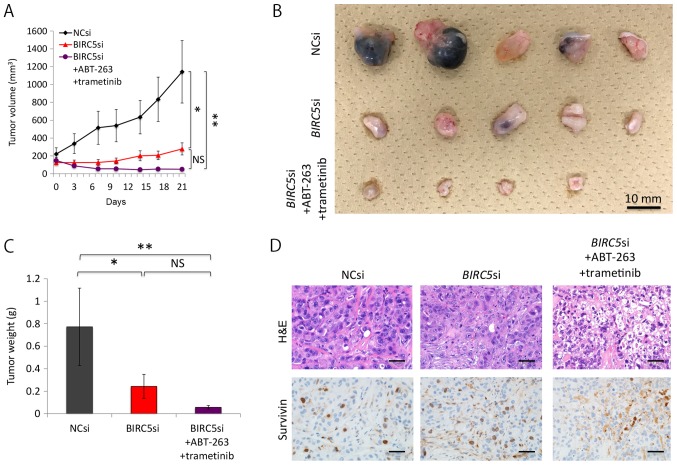Figure 6.
Triple combination of survivin knockdown, ABT-263, and trametinib decreases the size of xenografts of H358 cells. (A) Effects of the triple combination therapy on xenografts of H358 cells. Mice with tumor xenografts derived from BIRC5 siRNA-transfected cells were untreated (n=5) or treated (n=5) with ABT-263 (50 mg/kg) and trametinib (0.6 mg/kg) for 22 days. Mice with NC siRNA-transfected xenografts (n=5) were treated with vehicle. Drugs were administered once daily by oral gavage. Tumor volumes (means ± SD) were measured after the initiation of the AT treatment (day 1). 'Day 1' in this figure corresponds to the day 10 after implantation of the cells, when the AteloGene was also administered. Of note, one of the five mice with BIRC5 siRNA-transfected xenografts receiving AT treatment died during the experiment. The death at day 13 was probably due to the side-effects of trametinib used, as only this mouse developed a severe skin rash from day 10, when the administration to the mouse was terminated. As previously shown in clinical practice, the use of trametinib can lead to the development of skin rash (55). *P<0.05, **P<0.01. (B) Effects of the triple combination therapy on xenografts derived from H358 cells. Macroscopic images of the tumors resected from mice are represented. Fourteen tumor nodules presented herein were derived from the 14 mice that survived to the end of the therapy. (C) Effect of the triple combination therapy on xenografts of H358 cells. The weight of each tumor, shown in (B), was measured, and the results are presented as the means ± SD. *P<0.05, **P<0.01. (D) Pathological examination of xenografts. Hematoxylin and eosin (H&E) staining and immunohistochemistry for survivin of xenografts in each treatment condition. Of note, tumors derived from both the NC si-transfected and BIRC5 si-transfected cells without AT therapy expressed survivin in the nuclei, whereas the staining observed in the tumors derived from BIRC5 si-transfected cells with AT therapy were likely to reflect immunoglobulins derived from the mouse; i.e., non-specific staining.

